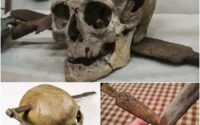The Nuwayrat Enigma: Ancient Egyptian Genome Unveils a 4,800-Year-Old Mystery .bongbenh
The Nuwayrat Enigma: Ancient Egyptian Genome Unveils a 4,800-Year-Old Mystery
Introduction
On July 2, 2025, a groundbreaking study published in Nature sent shockwaves through the online community: researchers had sequenced the first complete genome of an ancient Egyptian, a man buried in a ceramic pot within a rock-cut tomb in Nuwayrat, Egypt, around 4,500–4,800 years ago. Radiocarbon-dated to 2855–2570 BCE, this individual, dubbed the “Nuwayrat Man,” lived during the dawn of the Old Kingdom, when Egypt’s first pyramids rose under the pharaohs. The analysis revealed that 80% of his genetic ancestry traced to North African Neolithic populations, while 20% linked to the eastern Fertile Crescent, including Mesopotamia. This discovery, hailed as a scientific triumph, confirmed long-suspected cultural ties between Egypt and Mesopotamia but also sparked a frenzy of curiosity, confusion, and wild speculation on platforms like X. Who was this man? How did Mesopotamian DNA end up in an Egyptian potter’s tomb? And why does his high-status burial clash with his working-class life? This article explores the Nuwayrat Man’s story, the science behind it, and the internet’s fevered reaction, which has transformed an ancient genome into a modern-day mystery.
The Discovery: A Potter’s Tomb, a Genetic Treasure
The saga began in 1902, when British archaeologists unearthed a sealed ceramic pot in a rock-cut tomb at Nuwayrat, a necropolis 165 miles south of Cairo near Beni Hassan. Inside, curled with knees to chin, was the skeleton of a man who lived during the transition from Egypt’s Early Dynastic Period to the Old Kingdom, a time of cultural flourishing marked by the Step Pyramid of Djoser and the Great Pyramid of Khufu. Unlike the mummified remains of pharaohs, this man’s body was preserved naturally, untouched by the chemical treatments that often degrade DNA. Stored at the World Museum Liverpool after surviving Nazi bombings during World War II, the skeleton remained a quiet relic until 2025, when researchers from the Francis Crick Institute and Liverpool John Moores University extracted DNA from two of his teeth, achieving the first whole-genome sequence from an ancient Egyptian.
The genome, sequenced at 2× coverage, revealed a man aged 44–64—remarkably old for his era, equivalent to an 80-year-old today. Osteological analysis suggested he was a potter, with expanded seat bones, arm wear from repetitive motion, and arthritis in his right foot, consistent with stabilizing a pottery wheel. Yet, his burial in a rock-cut tomb, typically reserved for elites, hinted at a higher status, creating a paradox that baffled researchers. The genetic findings were even more startling: 80% of his ancestry matched North African Neolithic populations, likely local to Egypt, while 20% traced to the eastern Fertile Crescent, encompassing modern-day Iraq, Syria, and parts of Iran. This genetic blend suggested migration or intermixing between two of the ancient world’s greatest civilizations, Egypt and Mesopotamia, long before the pyramids reached their zenith.
The Science: Decoding a 4,800-Year-Old Genome
Extracting DNA from ancient Egyptian remains is notoriously difficult due to the region’s scorching climate, which accelerates genetic degradation. Previous attempts, like a 2017 study of three partial genomes from Abusir el-Meleq (circa 787–23 BCE), yielded limited data. The Nuwayrat Man’s preservation was exceptional, thanks to his burial in a sealed ceramic pot within a rock-cut tomb, which created a stable, dry environment. Researchers targeted the cementum of his teeth, a tissue ideal for DNA preservation, and successfully sequenced his genome, comparing it to over 3,000 modern and 805 ancient individuals. The results confirmed his mitochondrial haplogroup I/N1a1b2 and Y-chromosome haplogroup E1b1b1b2b, common in modern North African and West Asian populations, with no significant East or sub-Saharan African ancestry.
The 20% Mesopotamian ancestry was the bombshell. It aligned with archaeological evidence of trade—lapis lazuli, pottery techniques, and shared artistic motifs—but provided the first genetic proof of human movement between Egypt and the Fertile Crescent. The Nile River, described as an “ancient superhighway” by British Museum curator Daniel Antoine, likely facilitated this exchange. The findings raised tantalizing questions: Was the Nuwayrat Man a migrant from Mesopotamia? Did his ancestors intermarry with locals? Or did nomadic groups carry Mesopotamian genes to Egypt? The study’s lead author, Adeline Morez Jacobs, noted, “This genome offers a first glimpse into the genetic ancestry of an Old Kingdom Egyptian, but we need more samples to understand the full picture.”
The Online Frenzy: A Viral Vortex of Theories
When Nature announced the findings, X exploded with reactions. Posts like @NaturePortfolio’s (“The analyses reveal genetic ties to ancient populations in North Africa and Mesopotamia”) and @alfonslopeztena’s breakdown of the 80/20 ancestry split garnered thousands of retweets. Hashtags like #NuwayratMan and #EgyptianGenome trended globally, with users marveling at the science and speculating wildly about the man’s identity. Comments ranged from awe (“A potter’s DNA rewriting history!”) to confusion (“How did Mesopotamian genes get to Egypt 4,800 years ago?”). The facial reconstruction by forensic anthropologist Caroline Wilkinson, showing a man with brown eyes, brown hair, and dark skin, went viral, with some calling it “eerily lifelike” and others questioning its accuracy.
The online community, ever eager for a mystery, spun a tapestry of theories:
1. The Mesopotamian Migrant Theory
Many users linked the 20% Mesopotamian ancestry to migration, hypothesizing that the Nuwayrat Man or his parents were traders or artisans who traveled the Nile to Egypt. A thread by @HistoryNerdX cited ancient trade routes and shared pottery techniques, suggesting he was a skilled potter from Mesopotamia who gained status in Egypt. Others countered that 20% ancestry might indicate a distant ancestor, not a direct migrant, sparking debates about ancient mobility. The idea of the Nile as a “superhighway” fueled romanticized visions of cross-cultural journeys, with fan art depicting the man sailing between civilizations.
2. The Elite Potter Paradox
The man’s high-status burial in a rock-cut tomb clashed with his working-class occupation, leading to speculation about his identity. @ArfSleuth proposed he was a “master potter” whose skills earned him elite status, perhaps crafting ceremonial vessels for pharaohs. Others suggested he was a Mesopotamian envoy or merchant, buried with honors due to diplomatic ties. The contradiction—arthritis from hard labor versus a prestigious tomb—spawned memes of “the VIP potter” and fueled accusations that the burial was misidentified. Some even questioned whether the tomb was looted, with missing artifacts obscuring his true role.
3. The Lost Civilization Theory
A fringe group on X, led by @MysticOrigins, claimed the Mesopotamian DNA hinted at a lost civilization bridging Egypt and the Fertile Crescent. They pointed to myths of ancient “wanderers” and shared writing systems—cuneiform in Mesopotamia and hieroglyphs in Egypt—as evidence of a forgotten culture. While historians like Ben-Dor Evian dismissed this as speculative, the theory inspired wild posts about a “pre-pyramid super-society,” with some linking the man to pseudoscientific tales of Atlantis or alien visitors.
4. The Conspiracy Cover-Up
Skeptics on X, like @TruthSeeker88, accused researchers of hiding the full story. They noted Egypt’s strict regulations on DNA sequencing and suggested the Nuwayrat Man’s genome was cherry-picked to fit a narrative of cultural exchange. A now-deleted post claimed the World Museum Liverpool suppressed additional DNA samples showing “anomalous” results, fueling hashtags like #EgyptianDNACoverUp. While baseless, these claims tapped into distrust of institutional science, with some users demanding access to raw genetic data.
The Community’s Divide: Wonder vs. Wariness
The online reaction was a mix of wonder and wariness. History buffs and science enthusiasts celebrated the breakthrough, with @nianello6 tweeting, “No sub-Saharan ancestry, mostly North African with a Mesopotamian twist—this changes everything!” Others shared 3D renderings of the Nuwayrat Man’s face, sparking discussions about ancient Egyptian diversity. Educational accounts used #NuwayratMan to explain genomics, boosting public interest in ancient DNA.
But suspicion ran deep. Some users, citing older posts like @robertsepehr’s claim that ancient Egyptians had no sub-Saharan ancestry, argued the study was “revisionist” or politically motivated. Others questioned the facial reconstruction’s accuracy, noting that features like skin tone (predicted via HirisPlexS) carried uncertainty due to limited comparative data. A thread by @SkepticScribe demanded more samples, arguing that one genome couldn’t represent an entire civilization. The absence of follow-up posts from @PawsAcrossPonds, an unrelated account that shared the study, fueled confusion, with some mistaking it for a primary source.
Investigating the Enigma: What We Know
Despite the Nature paper’s rigor, gaps remain. The Nuwayrat Man’s identity—potter, migrant, or elite—is unclear, and his 20% Mesopotamian ancestry raises more questions than answers. Was he a first-generation migrant, or did his genes reflect centuries of intermixing? The tomb’s context offers few clues, as no artifacts like pottery or tools were reported, possibly due to early 20th-century excavation practices. The study’s authors, including Pontus Skoglund and Linus Girdland-Flink, plan to analyze more skeletons in British collections, but Egypt’s tight regulations on DNA sequencing limit access to local remains.
A tantalizing lead emerged on X, where @Ahmad_Bani_Abdo claimed the man’s Y-chromosome haplogroup E-V1515 suggested a broader Afroasiatic network, but the post’s link to a paywalled study left many frustrated. Attempts to geolocate Nuwayrat’s tomb via satellite imagery failed, as the site’s coordinates are imprecise. The facial reconstruction, while striking, drew criticism for speculative features like eye color, with some users joking it resembled “a modern Uber driver, not a potter.” The lack of additional genomes keeps the Nuwayrat Man an outlier, fueling speculation about what other tombs might reveal.

The Broader Implications: Rewriting Ancient Connections
The Nuwayrat Man’s genome underscores the interconnectedness of ancient civilizations, challenging romanticized views of Egypt as isolated. The 20% Mesopotamian ancestry suggests people, not just goods, moved across vast distances, possibly influencing innovations like writing or pyramid construction. The Nile’s role as a conduit for migration resonates with modern debates about cultural exchange, making the find a mirror for today’s globalized world. Yet, the single genome limits generalizations, and the online community’s hunger for answers reflects a broader distrust in partial narratives.
The study also highlights the challenges of ancient DNA research. Egypt’s climate and mummification practices have long thwarted genomic studies, making the Nuwayrat Man’s preservation a rare gift. As Sally Wasef, a paleogeneticist, noted, new techniques could unlock more genomes, but Egypt’s regulations and patchy artifact provenances complicate the work. The online buzz, from scholarly praise to conspiracy theories, shows how science can both illuminate and inflame public imagination.
Conclusion
As of July 4, 2025, the Nuwayrat Man remains a genetic enigma, his 4,800-year-old DNA bridging Egypt and Mesopotamia while sparking a digital storm. His story, blending hard science with tantalizing gaps, has captivated X, where #NuwayratMan continues to trend alongside memes, debates, and calls for more data. Was he a humble potter with elite connections, a Mesopotamian wanderer, or a clue to a lost chapter of human history? Until more genomes are sequenced, the Nuwayrat Man’s legacy endures as a puzzle—part fact, part mystery—that keeps the online community guessing, arguing, and dreaming of ancient worlds.


